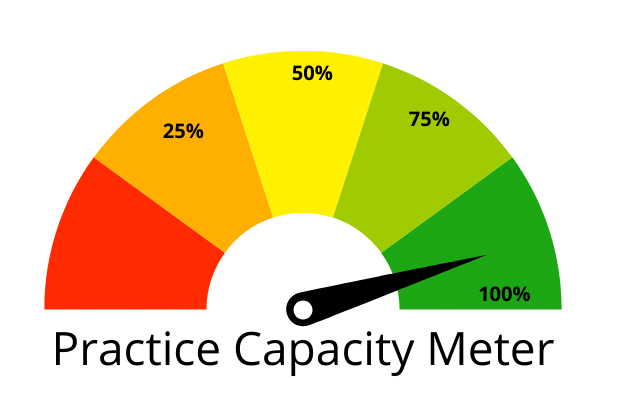
You have more expenses than you’ve probably considered.
Your biggest expense, like that old poster you have had in your reception room since 2012, has become invisible.
What is this big expense?
Well, one of the goals we work with in the Goal Driven System is the Full Capacity Goal.
This goal can be easily overlooked as we are focused on patient care, reimbursements, staffing schedules, vacations, and a thousand other tasks that require our attention.
The reason the use of goals is so effective in practice management is that they help you see the Vital Few from the Useful Many. (These terms are often used in reference to the Pareto Principle of 80/20.) The Vital Few are those factors (20% or less) that produce 80% (or more) of the results.
If you are not operating at close to full capacity, you are wasting money.
For example, if you could see, 160 patients in a week, given your schedule and good support, at $65 per visit, that would equal $10,400 per week. On a monthly basis, this would work out to be 640 visits and about $41,600 in revenue. This would be 100% Full Capacity.
You know from experience that your expenses are a lot higher than most realize. First, there are fixed expenses that you must pay out regardless of the performance of your business. And after everything and everyone is paid, after all accounts are settled, what is left over is yours.
At 70% capacity, that is not much. At 50% capacity, that is nothing.
Of course, you don’t focus on stats and money when you deal with patients as a doctor and as care givers.
But as a business owner, you must.
Numbers, analytics, Key Performance Indicators –– these make up your scoreboard and give you the best feedback to help you manage the performance of your business.
We carefully analyze our clients’ numbers each month and encourage they do the same. We also plot them on graphs and charts to notice trends. These are our x-rays.
Lately, we have realized that there is one number that gets overlooked in the hustle and bustle of business management. That is to what degree the office is operating at its full capacity.
In Goal Driven Analytics, we have been testing a “business capacitometer.” It displays, much like a speedometer or tachometer, the percentage of full capacity that the business is operating.
But you can easily do the same. Here is how:
-
Weekly Visits. Determine the maximum number of visits you could see comfortably each week if you were reasonably supported with software and staff. ______
-
Full Capacity Goal. Multiple this by 4 (I know, 4.3 is more exact): ___ This is your Full Capacity Goal.
-
Percent of Full Capacity. At the end of the month, divide the number of visits you saw by your full Capacity Goal and you will get the percentage that shows you how the efficiency of your practice. E.G. You FCG is 800 and you saw 600 = 600/800 = 75%
Work towards maintaining 90% or above. Find the capacity constraints and remove them.
This is also very helpful if you have multiple providers – other associate chiropractors, massage therapists, other services, even your rehab or therapy departments. After agreeing on what volume would be full capacity, each month they can see their level of performance.
Last note: It is not about the statistics. While stats are your best indicator, remember … it is not the stat that is important — it is what they represent. A helped person!
Seize the Future,
Ed
